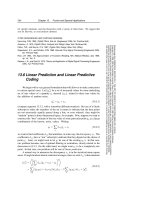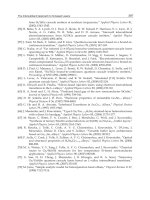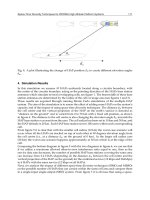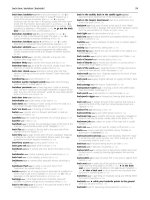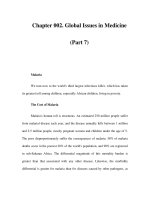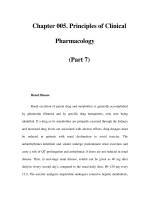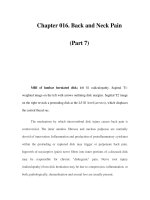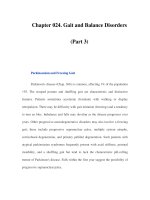Chapter 045. Azotemia and Urinary Abnormalities (Part 7) pptx
Bạn đang xem bản rút gọn của tài liệu. Xem và tải ngay bản đầy đủ của tài liệu tại đây (63.85 KB, 5 trang )
Chapter 045. Azotemia and
Urinary Abnormalities
(Part 7)
Isolated microscopic hematuria can be a manifestation of glomerular
diseases. The RBCs of glomerular origin are often dysmorphic when examined by
phase-contrast microscopy. Irregular shapes of RBCs may also occur due to pH
and osmolarity changes produced along the distal nephron. There is, however,
significant observer variability in detecting dysmorphic RBCs. The most common
etiologies of isolated glomerular hematuria are IgA nephropathy, hereditary
nephritis, and thin basement membrane disease. IgA nephropathy and hereditary
nephritis can lead to episodic gross hematuria. A family history of renal failure is
often present in patients with hereditary nephritis, and patients with thin basement
membrane disease often have other family members with microscopic hematuria.
A renal biopsy is needed for the definitive diagnosis of these disorders, which are
discussed in more detail in Chap. 277. Hematuria with dysmorphic RBCs, RBC
casts, and protein excretion >500 mg/d is virtually diagnostic of
glomerulonephritis. RBC casts form as RBCs that enter the tubule fluid become
trapped in a cylindrical mold of gelled Tamm-Horsfall protein. Even in the
absence of azotemia, these patients should undergo serologic evaluation and renal
biopsy as outlined in Fig. 45-2.
Isolated pyuria is unusual since inflammatory reactions in the kidney or
collecting system are also associated with hematuria. The presence of bacteria
suggests infection, and white blood cell casts with bacteria are indicative of
pyelonephritis. White blood cells and/or white blood cell casts may also be seen in
tubulointerstitial processes such as interstitial nephritis, systemic lupus
erythematosus, and transplant rejection. In chronic renal diseases, degenerated
cellular casts called waxy casts can be seen in the urine. Broad casts are thought to
arise in the dilated tubules of enlarged nephrons that have undergone
compensatory hypertrophy in response to reduced renal mass (i.e., chronic renal
failure). A mixture of broad casts typically seen with chronic renal failure together
with cellular casts and RBCs may be seen in smoldering processes such as chronic
glomerulonephritis.
ABNORMALITIES OF URINE VOLUME
The volume of urine produced varies depending upon the fluid intake, renal
function, and physiologic demands of the individual. See "Azotemia," above, for
discussion of decreased (oliguria) or absent urine production (anuria).
The physiology of water formation and renal water conservation are
discussed in Chap. 272.
Polyuria
By history, it is often difficult for patients to distinguish urinary frequency
(often of small volumes) from polyuria (>3 L/d), and a 24-h urine collection is
needed for evaluation (Fig. 45-4). Polyuria results from two potential mechanisms:
(1) excretion of nonabsorbable solutes (such as glucose) or (2) excretion of water
(usually from a defect in ADH production or renal responsiveness). To distinguish
a solute diuresis from a water diuresis and to determine if the diuresis is
appropriate for the clinical circumstances, a urine osmolality is measured. The
average person excretes between 600 and 800 mosmol of solutes per day,
primarily as urea and electrolytes. If the urine output is >3 L/d and the urine is
dilute (<250 mosmol/L), then total mosmol excretion is normal and a water
diuresis is present. This circumstance could arise from polydipsia, inadequate
secretion of vasopressin (central diabetes insipidus), or failure of renal tubules to
respond to vasopressin (nephrogenic diabetes insipidus). If the urine volume is >3
L/d and urine osmolality is >300 mosmol/L, then a solute diuresis is clearly
present and a search for the responsible solute(s) is mandatory.
Figure 45-4
